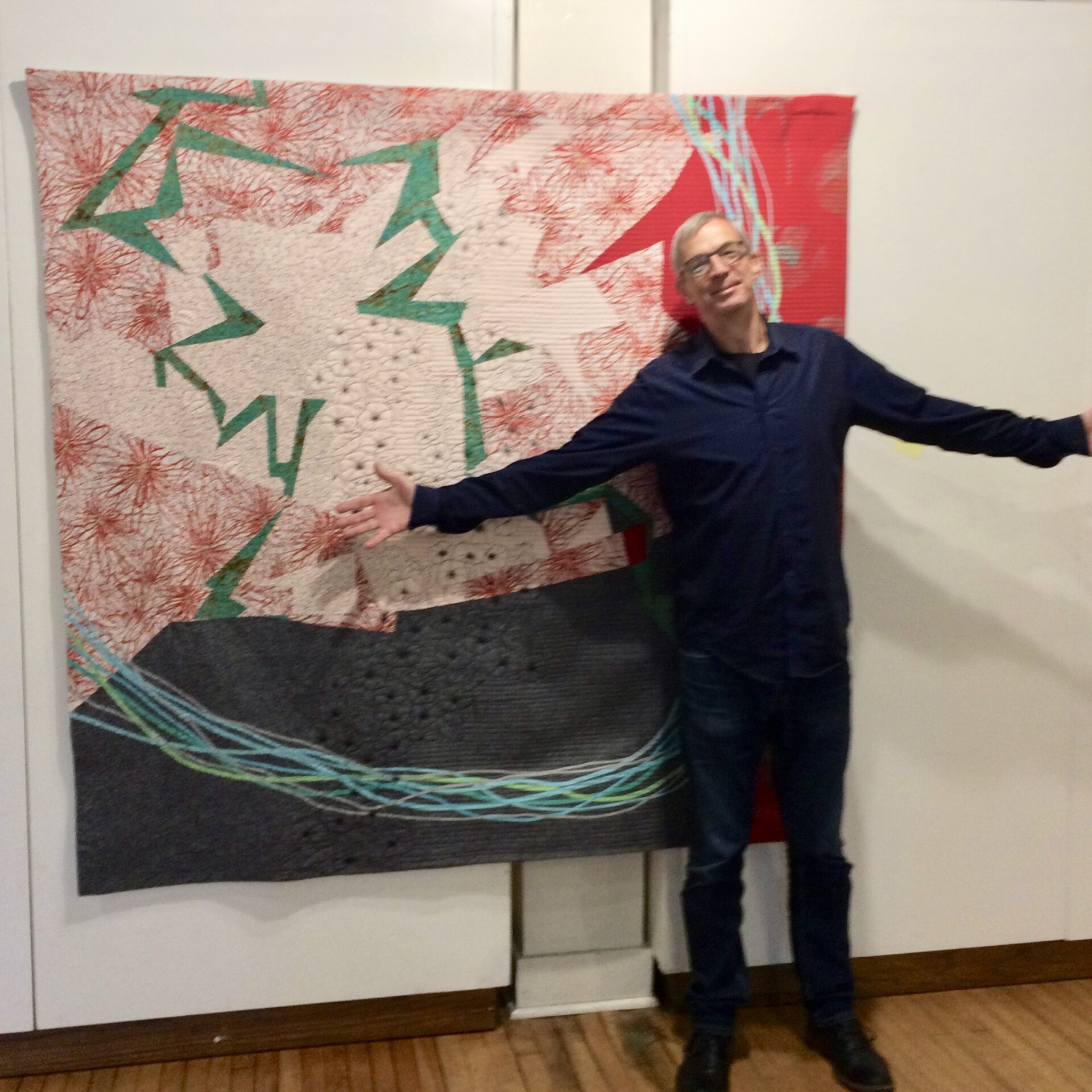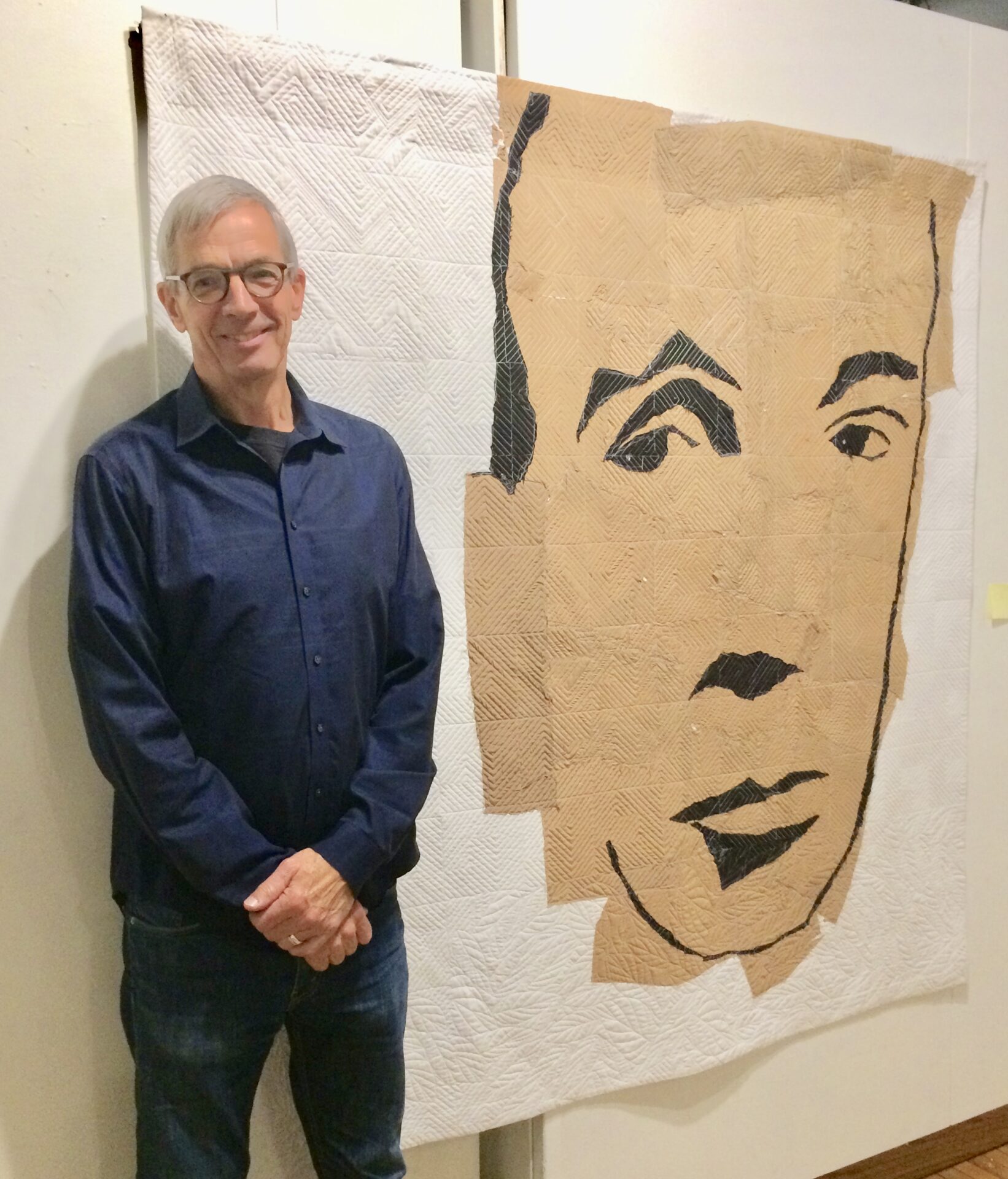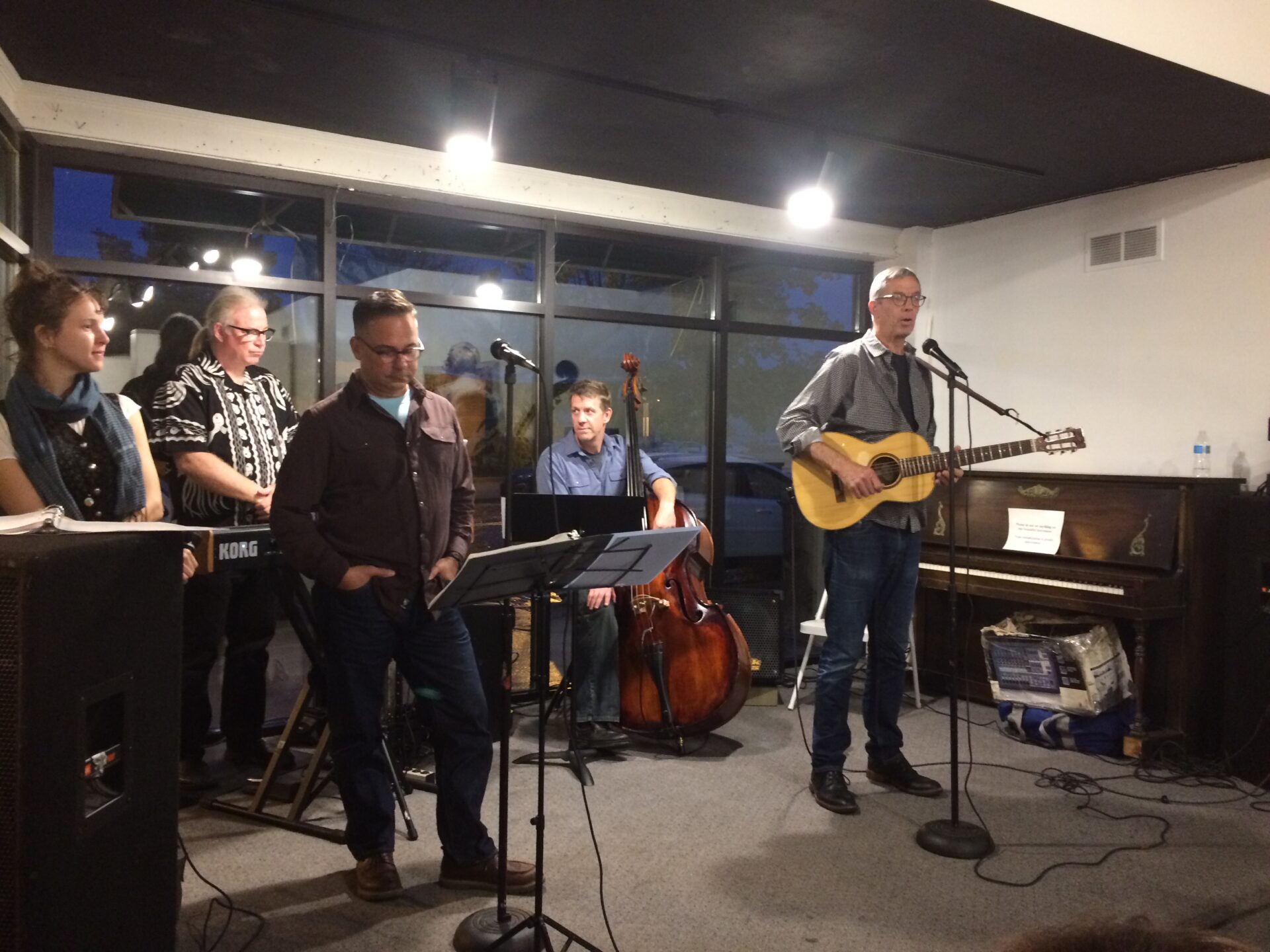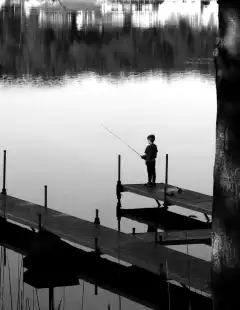By Jan Worth-Nelson
Nationally-recognized quilter and musician Joe Cunningham has not just cleared the path for male quilters across the country, but also has led quilting in general into the fine arts world over the past two decades, according to Greater Flint Arts Council president and CEO Greg Fiedler.
And as it happens, Cunningham’s love of quilting began with an experimental little hoop, an apartment on Thomson Street, and a prod from a quilting matriarch who became for years his partner — in music, in quilts, and in life.
Fiedler and GFAC hosted Cunningham, 65, a Swartz Creek native, back to town recently as part of the three-day Flint Festival of Quilts.
Cunningham’s visit to Flint included a lecture, a workshop and a standing-room-only concert at GFAC, at which he was joined by one of his mates, Christopher Gray, from his San Francisco band, the Potrero Hillbillies.

Quilter Joe Cunningham with his Swartz-Creek-themed piece “The Creek Dreams it’s a River” on exhibit at GFAC through Nov. 3 (Photo by Jan Worth-Nelson)
“People were surprised by Joe’s quilts,” Fiedler said. “They’re expecting log cabin and star quilts, all the old traditional patterns, and then they see these quilts that are totally original. They were just awestruck by how creative and beautiful they are. They show a total love for what he’s doing.”
An exhibit of 20 of Cunningham’s quilts are on the walls of GFAC through Nov. 3. All are for sale.
Cunningham’s life has centered in San Francisco since 1993, after far-flung sojourns in Vermont and Colorado. But the thrust of his life took its original energy in a Flint arts scene in the 1980s that Cunningham remembers as “electrifying” — a time in the city when, as things kept getting darker and more desolate, artists thrived.
An aspiring writer back then, Cunningham got a job writing a catalog for revered Flushing quilter Mary Schafer. Schafer’s 300-quilt collection had been passed along for documentation to Gwen Marston, also a quilter, a divorcee living on Woodside Drive and 15 years Joe’s senior.
One night she showed up at his Thomson Street apartment with a little quilt hoop and a needle and said, “If you’re going to write about quilts, you really should know how to do it.” So began the rest of his life. Soon Marston invited him to work at her frame, and then he started making his own quilts. The two became a quilting colleagues, musical colleagues, and then a couple. The Suttle Family band coalesced, performing often in long-gone downtown venues of the time — Doobies, the Rusty Nail, and Hat’s Pub.
As their shared love of quilting evolved, so did their partnership. From another friend, they heard about Beaver Island, where. the friend said, “You could buy little cottages up there for nothing.” They bought five acres together and set out to build a house. At first they spent six weeks every summer quilting and running quilting workshops on the island. Then in 1983, though their roots were deeply set in Flint, they moved to Beaver Island full time.
They became professional quilt makers. Cunningham began writing magazine articles, “riding a wave from the Bicentennial. he says, “trying to get quilts to be valued — not just blankets from your grandma made to wear out,” he says. “We were also entertainers — we could go out in front of a crowd, and we were like no other quilt makers at the time,” he said.
******
Cunningham grew up on a dirt road, the son of a GM worker with a seventh-grade education. Despite that they were “totally unworldly,” he said, the family had a set of Collier’s Encyclopedias and young adult classics, which he devoured, although conventional school was not his strong suit. He said back then he was “high all the time,” a “horrible student,” and it took him extra summer school to graduate from Swartz Creek High in 1970.

Cunningham with his quilt “Self Portrait” on exhibit through Nov. 3 at the Greater Flint Arts Council (Photo by Jan Worth-Nelson)
“When I went to a museum in the eighth grade, when I went to the Flint Institute of Arts, and that door kind of whooshed open and I heard the sound of the museum, I felt like I was at home for the first time — this is ME,” Cunningham remembers.
In high school,”All I wanted to do was get high and play my guitar,” Cunningham remembers. He was doing uppers and downers and acid and mescaline, and behind it all, he says, “All I cared about was art.”
Once after a bungled performance when he was disastrously high, he realized he had to decide between drugs and music. He picked music. Quilts, a different absorption, were still to come.
Years later when Cunningham sought out downtown Flint life, he went back to the FIA, getting to know Mott Community College artists and art teachers Doug Hoppa and Tom Nuzum,. He got to know a group of poets often performing at Hat’s Pub. Buckham Gallery started, a gathering point alternative to the FIA. Cunningham and Marston rented a studio downtown and began getting a national reputation.
Everything in Flint was going down, down, down, but the arts scene was “so intoxicating…it was thrilling,” Cunningham says. He was reading Susan Sontag and Clement Greenberg — “I didn’t understand half of it, but I loved it,” he remembers. He was following what was happening in New York, and “here in my own hometown I could be part a real arts scene, too.”
“We were all trying to be great,” he recalls, “we were all trying to do great things. And when your friends are trying to be great, you want to be great.” He says he felt like “a poser back then,” idolizing the late Johnny Johnson, who was killed instantly with another musician, Bruno Valdez, in a traffic accident on Chavez Street late one night. But he kept going anyway.
******
In the interest of full disclosure, I was part of that 80s scene. After coming to Flint in 1981, alone, broke and in my early 30s, I found Hat’s Pub at the corner of Kearsley and Harrison, and like a lot of other downtown habitués, I hung out at Hat’s back room, where Joe and Gwen’s band, the Suttle Family, often performed. I was a frequent open mic night poet back then, and I met my first husband, another poet named Danny Rendleman, through that vivid, lively scene.
Even though they were sometimes off key and even though I was often drunk, I loved those nights when the Suttle Family rocked out for a bunch of downtown misfits, students, artists, poets and shop rats. I thought Marston was sexy as hell, and the notion that she and Joe were partners, defying convention with more than 15 years between them, seemed excitingly cosmopolitan. Their headline vocalist was Debi Mcfarlan, a talented blues singer who still can be spotted around town, though to my knowledge she hasn’t been persuaded to reprise that chanteuse past. The other members were Lex Morris on bass and Paul Lines on drums.
Those were some great nights.
******
At some point in the late 70s Cunningham and Marston met photographers and videographers Ken Hannon and Valerie Clarke, a power couple at the time in the arts community, whose KEVA Partnership influenced many artists and arts initiatives in town. Hannon and Clarke were taken with possibilities for documenting and marketing Cunningham and Marston’s quilt endeavors, and they collaborated closely, also spending many weeks on Beaver Island.
In 1994, Hannon and Clarke established the first Flint Festival of Quilts, which this year included hundreds of quilters and encompassed eight locations. The festival was a direct outgrowth of their work with Marston and Cunningham.
Eventually, both relationships ended. Marston and Cunningham split up in the early 90s and Hannon and Clarke parted ways years later. Clarke died in 2014.
But Cunningham had found his genre. After years fighting it, he eventually surrendered to the notion that his quilt work is “art.” It’s an identity, considering his wildly original abstracts, that he has come to cherish and embrace.
“I’m an artist — that’s my disease,” he says, “and who cares? Why does it have so much freight? But I got over it. Big deal.”
His career from the West Coast has flowered, his work in private collections and displayed in museums around the world, and he regularly conducts quilting workshops and exhibits across the country and recently in Finland. He has written or co-written 12 books, including the 2010 title “Men and the Art of Quiltmaking,” the first book on that topic. He and his wife Carol LeMaitre, a former dancer with The Residents and owner of a Pilates studio in San Francisco, have two sons, Jules and Dorian.

Cunningham back in Flint, playing to a standing room only crowd at GFAC Oct. 14 (Photo by Jan Worth-Nelson)
Meanwhile, he still is playing music and writing lyrics. At his recent GFAC concert, he regaled and delighted the crowd with two sets of his wry, funny songs like “Body image problem,” “Slow but Sure” and “Honey I got a high IQ for you,” (“Writing sincere loves songs was always a problem for me — until I found out you could write one about yourself,” he wise- cracked in introducing “Genius.”)
His gratitude and fondness for his roots in Flint have never wavered.
“I wear it as a badge of honor that I’m from Flint — I’m an outsider because of it. Nobody can imagine that there’s anything of value here,” he said, and he is pleased to surprise them. But sometimes it’s more than a little haunting to return.
“Talk about ghosts – yi-yi-yi, so much of my own history is here,” he says. “I drive around around and I feel all of it, all the houses I lived in, people that I’ve wronged, people that aren’t here any more. It’s like getting thumped in the chest.”
“I sat down at the bar in the Torch the other night,” he said, “and I didn’t know a soul. To not know anybody, after all the drama I had in that room — I felt like a ghost myself. The bartender asked me what I wanted and I said, “Any fucking thing you want to give me.” Lost in thought, he doesn’t remember what it was.
EVM Editor Jan Worth-Nelson can be reached at janworth1118@gmail.com.


You must be logged in to post a comment.